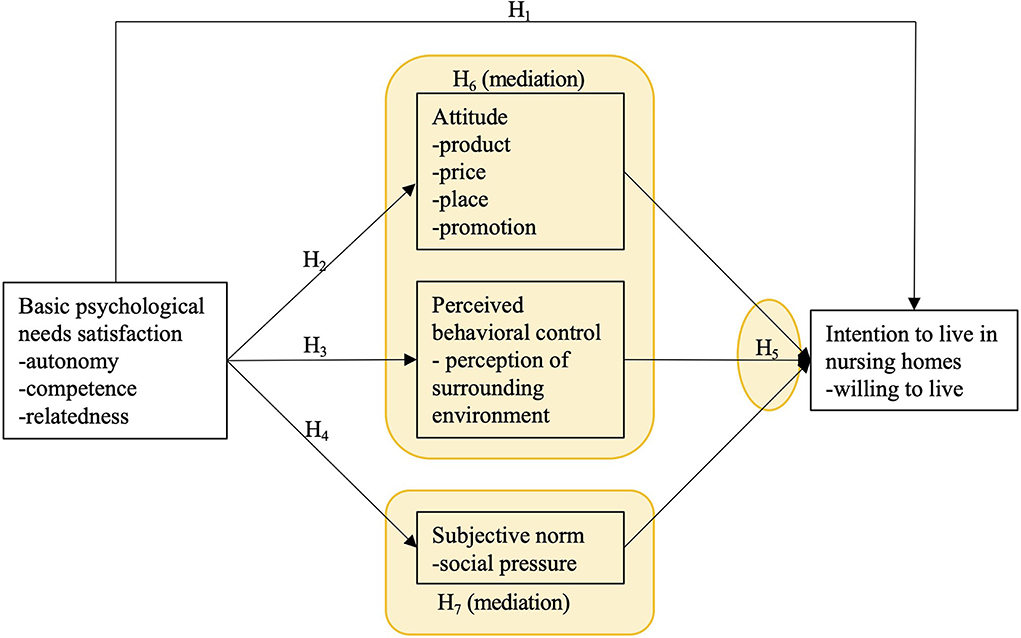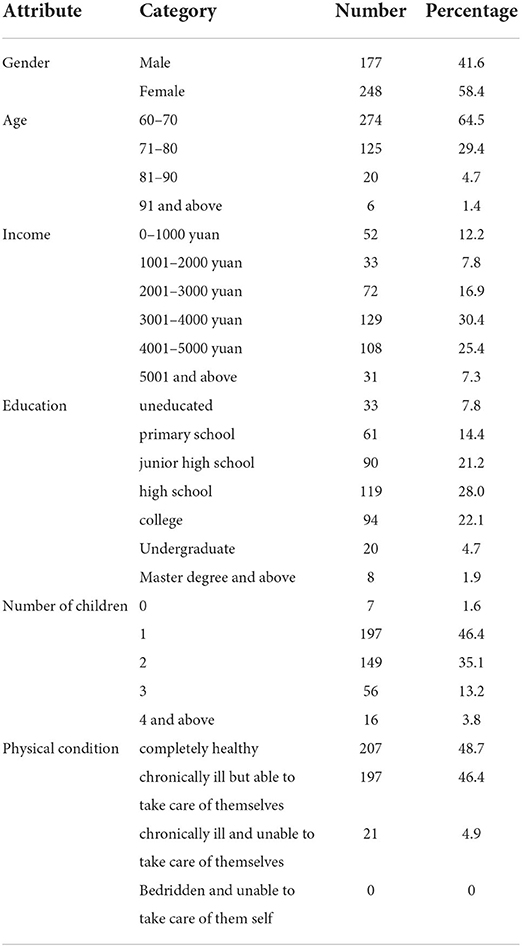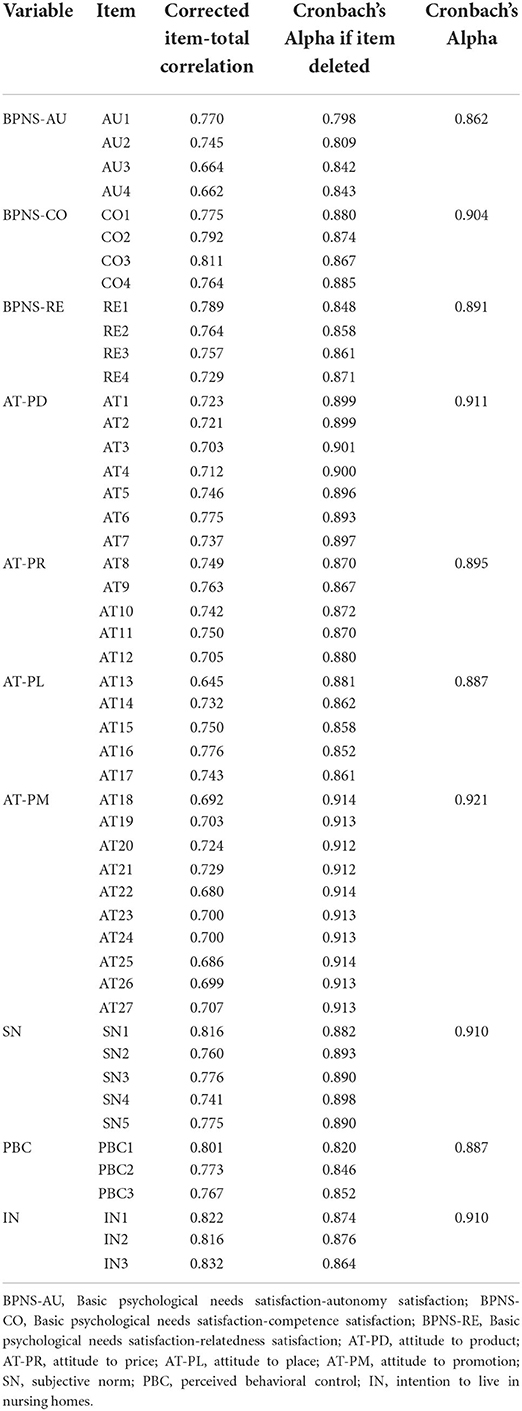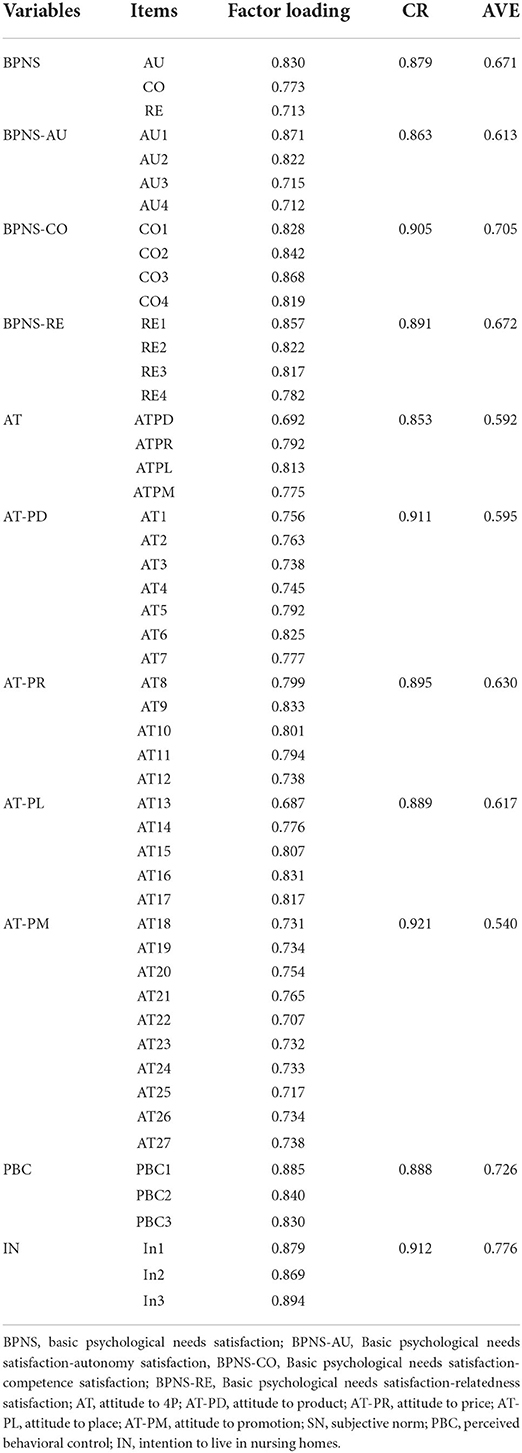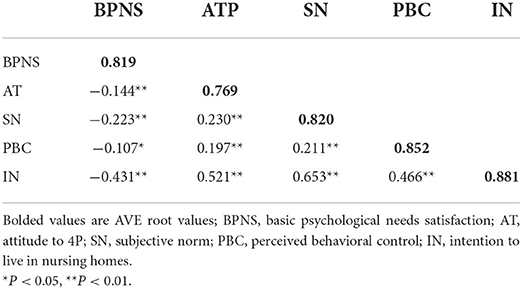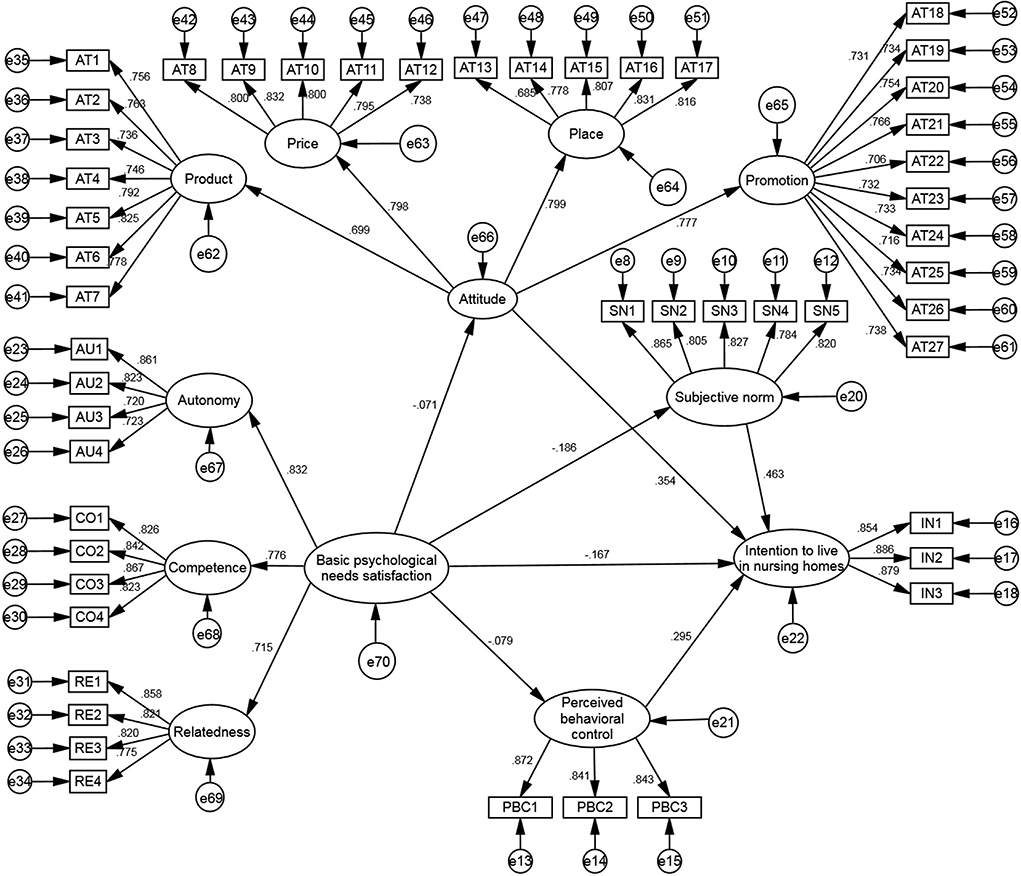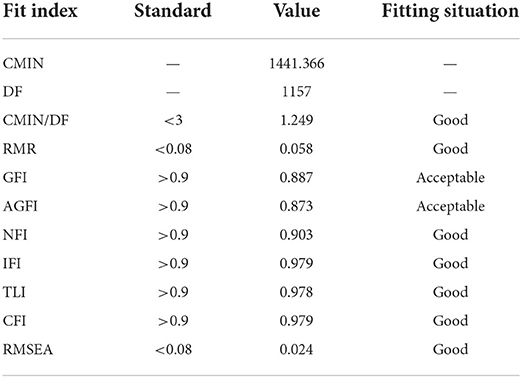- 1Rattanakosin International College of Creative Entrepreneurship, Rajamangala University of Technology Rattanakosin, Nakhon Pathom, Thailand
- 2Department of Economics and Finance, Faculty of Commerce, Hong Kong Shue Yan University, Hong Kong, Hong Kong SAR, China
- 3Faculty of Humanities, Kasetsart University, Bangkok, Thailand
The growing number of aging populations has become a major problem worldwide. Nursing homes play an essential role in the later life of older adults. Previous research indicated potential associations between external factors and older adults' intention to live in nursing homes. However, intrinsic motivation has yet to be fully understood. This article addresses an academic void that integrated the Basic Psychological Needs Theory (BPNT) and the Theory of Planned Behavior (TPB) to explore older adults' intentions to live in nursing homes. More specifically, it tested the effects of autonomy, competence, and relatedness needs satisfaction as defined in the BPNT on attitudes, subjective norms, perceived behavioral control, and live-in intentions toward nursing homes in the TPB. An online survey provided quantitative data from 425 aging people. The results indicated that the higher the satisfaction of the basic psychological needs (i.e., autonomy needs, competence needs, and relatedness needs) of the older adults, the lower their intention to live in nursing homes. Furthermore, social pressure partially mediates this relationship. That is, the higher the satisfaction of the basic psychological needs of older adults, the lower the pressure from society. Thus, they should be admitted to the nursing home, and the lower their intention to live in nursing homes. The results contribute to a better understanding of the deep psychological motivation of the older adults' intention to live in nursing homes and support further development of the BPNT-TPB model in older adults' health research.
Introduction
Addressing an aging population has long become a question of great interest in various fields. China is one of the countries with the fastest aging population (1). While many older adults live separately from their adult children, leading to more and more “empty nest” families (2), older adults' frailty raises the need for nursing homes. In the last few decades, there has been a surge of interest in older adults' intention to live in nursing homes (3). Previous studies on the intention to live in nursing homes have typically concentrated on demographic factors (4–7) and children's financial and emotional support (4, 8, 9). Nevertheless, the rapid changes in China's demographic, social and economic conditions weaken the traditional home care system (3).
It is observed that the integration model of self-determination theory (SDT) and planned behavior theory have yielded promising results in different studies (10–13). Nevertheless, no study has investigated the self-determination theory's role in the older adults' intention to live in nursing homes, not to mention the use of the integration model. The basic psychological needs theory is one of the six mini theories of self-determination theory (14). Given the above, this paper has two aims. First, it investigates the effect of three psychological needs satisfaction on the older adults' intention to live in nursing homes. Second, test the Chinese older adults' intention to live in the nursing home using the integration model.
Literature review and hypothesis development
Nursing homes
Sanford et al. (15) have reached an international consensus on the definition of the “nursing home” and what type of services the “nursing home” provides. Therefore, the nursing home in this context refers to a facility with a domestic design that provides 24-h functional support and care to older adults who need help with their daily activities, who often have complex health needs and increased vulnerability. The older adults in nursing homes are self-care, semi-self-care, and non-self-care elders. Most nursing homes mainly accept residents who need long-term care. Most of the employees in nursing homes are trained nurses.
Basic psychological needs theory
According to Ryan et al. (16), everyone must meet three needs to protect their mental health and the best human functions. The three most basic needs are “autonomy,” “competence” and “relatedness.” Autonomy needs satisfaction refers to the feeling that the individual is free to initiate, maintain, and terminate the target behavior (17). Competence needs satisfaction refers to the perception that one can influence the environment in an ideal way and complete a task within the scope of his ability (17); relatedness needs satisfaction refers to an individual's feeling that they can maintain a good relationship with significant others: care for each other and support each other (18). These needs are cross-personal and cross-cultural and apply to every aspect of life (19). Meeting these needs is essential; they guide people's behavior and are a potential behavioral incentive (17, 20).
Theory of planned behavior
Ajzen (21) proposed that attitude, subjective norm, and perceived behavioral control together form behavioral intentions. In TPB theory, the intention is defined as an “indication of how hard people are willing to try, of how much effort they are planning to exert, performing the behavior” (21). Attitude refers to an individual's positive or negative evaluation of a specific intention and behavior. Perceived behavioral control is used to describe whether the behavior is complex and whether it is under their control (21). Subjective norms can be defined as the social pressure perceived by significant others or reference groups (22).
BPNT-TPB framework
A common criticism of predicting human behavior using TPB or basic psychological needs theory basic psychological needs theory (BPNT) alone concerns a lack of motivation. The theory of planned behavior is believed to overlook the origin of social cognitive beliefs; self-determination theory fails to explain the contingency of situations nor the process of transforming motivational orientation into behavioral intentions and behaviors (23, 24).
Some scholars tend to integrate self-determination theory with the theory of planned behavior to address these shortcomings. Drawing on 45 tests of SDT-TPB structures, Hagger and Chatzisarantis (12) used meta-analysis to examine the motivation sequence. The results indicated that the proximal predictors of TPB partially mediated the significant effect of SDT on intention. The basic psychological needs theory is the most widely used SDT's six mini-theories (14). Consequently, this study assumed that the BPNT-TPB model is appropriate for studying older adults' intentions to live in nursing homes. This study classifies essential psychological needs satisfaction into three dimensions: autonomy needs satisfaction, competence needs satisfaction and relatedness satisfaction (16), and explores the more complicated relationship between BPNT and TPB variables. The framework model is as shown in Figure 1.
Development of hypotheses
Relationship between basic psychological needs satisfaction and intention
Al-Jubari (25) suggested that autonomic motivation occurs when an individual's behavior satisfies basic psychological needs, namely autonomy, competence, and relatedness. Hagger (26) pinpointed those essential psychological needs satisfaction, directly and indirectly, affected intention. Besides, according to Harris et al. (27), the SDT suggested that people who have been adequately satisfied with psychological needs were more likely to engage in actions to sustain their sense of autonomy, competence, and relatedness needs. Therefore, older adults who meet basic psychological needs in their daily lives may continue their original lifestyle to meet their needs of autonomy, competence, and relatedness. They are expected to be less willing to live in nursing homes. So, this research proposes hypothesis 1:
H1: Basic psychological needs satisfaction negatively influences the intention to live in nursing homes.
Relationship between basic psychological needs satisfaction and TPB variables
Individuals align their cognitions and emotions with overall motivation, resulting in self-motivated behaviors to meet the basic psychological needs of autonomy, competence, and relatedness (28). Deci et al. (29) pointed out that the satisfaction of people's needs for autonomy, competence, and relatedness facilitates internalizing their values and supervision processes, which was verified in another study (30). González-Cutre (31) concluded that TPB lacks the origin of the belief, and an individual's pursuit of basic psychological need satisfaction provides the reasons for attitude, intention and behavioral engagement. These research results agreed that the basic psychological need satisfaction predicts proximal factors of TPB: attitudes, subjective norms and perceived behavioral control.
Previous research has concluded that the satisfaction of three basic psychological needs positively affects individual exercise participation in sports (32). According to Baard et al. (33), people with higher satisfaction with their needs usually have a positive attitude toward the target behavior and find it easier to exhibit positive behavior. Similarly, Baard et al. (33) suggested that the higher people's satisfaction with the three needs, the higher their self-esteem and welfare. Al-Jubari (25) researched college students' entrepreneurial intentions and found that satisfaction with basic psychological needs positively affected entrepreneurial attitude, perceived behavioral control, and the subjective norm.
Therefore, this study speculate that for the Chinese older adults, the higher the basic psychological needs satisfaction, the more positive their attitude toward continuing their original life, but the more negative their attitude toward nursing homes. At the same time, there will be less pressure on significant others around them to put them in nursing homes, and the subjective norm will be lower. On the contrary, the higher basic psychological needs satisfaction of the older adults are associated with a higher the perceived behavioral control. This research proposes hypotheses 2–4:
H2: Basic psychological needs satisfaction negatively influences attitude.
H3: Basic psychological needs satisfaction negatively influences subjective norms.
H4: Basic psychological needs satisfaction positively influences perceived behavioral control.
Relationship among TPB variables
In a seminal paper, Ajzen (21) provides the earliest description of TPB that behavioral intention is a function of attitude, subjective norm, and perceived behavioral control. In a recent nursing home study, Huang's (34) research show that attitude and perceived behavioral control directly affect the intention to move into a nursing home. Subjective norms have the most negligible effect on intention but strongly affect intention through attitude. The mediation effect shows that their opinions and social perceptions will affect attitudes and thus affect behavioral intentions of moving into a nursing home. At the same time, perceived behavioral control also strongly influences the intention of older adults to move into nursing homes. No matter how positive their attitude toward moving into senior housing is nor how significant others support their decision, their intention to move in will decrease as long as there are potential restrictions. Therefore, this study proposes hypotheses 5–7:
H5: Attitude, subjective norms, and perceived behavioral control positively influence the intention to live in nursing homes.
Mediation effect on TPB variables
Many scholars have integrated SDT and TPB to explain the processes behind the behavior. Hagger's (26) motivational sequence research found that basic psychological needs satisfaction affects intentions via attitudes and perceived behavioral control. At the same time, the subjective norm's effect is insignificant. This view is supported by Barkoukis (35), who found that the proximal predictors of TPB: attitude, subjective norm, and perceived behavioral control mediate the effect of basic psychological need satisfaction on the intention to exercise leisure time. Similarly, Al-Jubari (25) underlines that attitude and perceived behavioral control completely mediate the effect of satisfying the basic psychological needs of college students' entrepreneurial intention. Therefore, we hypothesized that the basic psychological needs satisfaction indirectly impacts intention via attitude, subjective norms and perceived behavioral control. Therefore, this research proposes hypotheses 8–10:
H6: Attitude and perceived behavioral control mediate the effect of basic psychological needs satisfaction on the intention to live in nursing homes.
H7: Subjective norms play a mediating role in the effect of basic psychological needs satisfaction on the intention to live in nursing homes.
Methods
Population and sampling technique
This study employed a cross-sectional survey method and distributed electronic questionnaires from January to February 2022. The target population was “the older adults over 60 years old, living in Henan, China, sober-minded, able to use a smartphone.” According to the sampling formula (36), a minimum of 387 samples should be drawn to ensure accuracy. Our study collected a total of 425 valid questionnaires.
Respondents characteristics
A total of 425 respondents completed the questionnaire, 117 were male and 248 were female. 64.5% of respondents were aged 60–70 years old. 30.4% of respondents had income between 3,001 and 4,000 yuan. 28.0% of respondents were educated in high school. 46.4% of respondents had only one child, and 48.7% of respondents' physical condition was completely healthy. Table 1 provides an overview of the respondent's gender, age, income, education, number of children, and physical condition.
Research instrument and statistical analysis
This study used a 6-point scale to let respondents choose (37). The research instrument was scaled that has been validated. Basic psychological needs satisfaction was measured using the psychological satisfaction portion of Chen et al.'s (38) scale, attitude referenced by Purnomo et al.'s (39) scale (attitude to 4Ps: product, price, place, and promotion), subjective norm and perceived behavioral control used Nsoh's (40) scale, intention adopts Xie et al.'s (41) scale. The software used are SPSS and AMOS. The key statistical analysis used is descriptive, reliability, validity, correlation, regression, mediating effect analysis and structural equation modeling.
Results
Reliability analysis
Reliability analysis uses Cronbach's alpha reliability coefficient to check the consistency of questionnaire research variables on each measurement item. It can be seen from Table 2 that Cronbach's alpha coefficient of each variable is greater than the standard of 0.7 (0.862–0.921), indicating that the variable has good internal consistency reliability. The “Corrected item-total Correlation” number is greater than the standard of 0.5 (0.645–0.832), indicating that the measurement items meet the research requirements. “Cronbach's Alpha if Item Deleted” shows that deleting any item will not cause Cronbach's alpha value to increase, indicating that the variable has good reliability (42).
Convergent and discriminant validity
Table 3 shows that the standardized factor loadings of each item are greater than 0.6 (0.687–0.894), the combined reliability (CR) is more significant than 0.7 (0.853–0.921) and the average variation extraction (AVE) is more significant than 0.5 (0.540–0.776), indicating that each variable has good convergent validity (43).
CFA can also be used to analyse the discriminant validity of the scale. Table 4 presents the results of the discriminant validity analysis of the scale. The diagonal line in the table is the AVE square root value, and the rest are the correlation coefficients. The AVE root of each factor is greater than the standardized correlation coefficient outside the diagonal, so the scale has good discriminant validity. Therefore, based on the above analysis, the scales of this study have good validity (43).
Hypothesis testing, model fit and path analysis
This study used a structural equation model, as shown in Figure 2, where the hypotheses were tested concerning the model fit, path coefficient, and mediation test.
The results of the model fit analysis are presented in Table 5. Table 5 showed that CMIN/DF = 1.249, GFI = 0.887, AGFI = 0.873, NFI = 0.903, IFI = 0.979, TLI = 0.978, CFI = 0.979, and RMSEA = 0.024, which indicated that the fitness of the measurement model was acceptable.
Table 6 summarizes the results obtained from the preliminary analysis. Basic psychological needs satisfaction significantly negatively affects intention (β = −0.167, p < 0.001), so H1 is supported. Basic psychological needs satisfaction has no significant effect on attitude (β = −0.071, p > 0.05), so H2 is not supported. Basic psychological needs satisfaction significantly negatively affects subjective norm (β = −0.186, p < 0.01), so H3 is supported. Basic psychological needs satisfaction has no significant effect on perceived behavioral control (β = −0.079, p > 0.05), so H4 is not supported.
Attitude has a significant positive effect on intention (β = 0.354, p < 0.001), the subjective norm has a significant positive effect on intention (β = 0.463, p < 0.001), and perceived behavioral control has a significant positive effect on intention (β = 0.295, p < 0.001), so H5 is supported.
Mediating effect analysis
The mediating effect is not supported if the path from the independent variable to the mediating variable is insignificant. The results obtained from 4.3, H2 and H4 are not supported. So, the mediating effects of attitude and perceived behavioral control are not supported. H6 is not supported.
The bootstrap method is one of the most suitable methods for verifying the mediation effect (44, 45). Therefore, the bootstrapping method was used to verify the mediating effect. When the 95% confidence interval excludes 0, the effect is significant. Conversely, when the 95% confidence interval for the direct effect includes 0, the effect is insignificant. Under the premise that the total effect is significant, if both the indirect effect and the direct effect are significant, then the variable has a partial mediating effect; if the direct effect is not significant and the indirect effect is significant, then the variable has a full mediating effect (45).
Table 7 shows that the indirect effect value of BPNS_SN_IN is −0.086. The 95% confidence interval is (−0.156, −0.011) and (−0.159, −0.012), excluding 0, indicating that the indirect effect is significant, so H7 is supported. The direct effect of BPNS_IN is −0.171. After adding the subjective norm, the total effect of BPNAU_IN is −0.318, so the Subjective norm has a partial mediating effect.
Discussions and conclusion
It is worth mentioning that our research found that basic psychological needs satisfaction harms the Chinese older adults' intention to live in nursing homes. This finding is consistent with the hypothesis of this study. Meeting people's basic psychological needs can promote their physical and psychological wellbeing (17). In the whole life cycle of older adults, “living in a nursing home” manifests regression and weakening of personal ability. Therefore, the higher the basic psychological needs satisfaction of the older adults, the less willing they are to live in nursing homes.
The surprising correlation is basic psychological needs satisfaction did not affect the older adults' attitude to nursing homes. These results differ from previous studies (12, 13). They may somewhat limit these findings. It could be argued that the positive results were due to the attitude scale using the attitude's 4Ps scale (attitude to nursing homes' product, price, place and promotion). The scale includes 27 items with four dimensions: prices, product, place and promotion. Compared with the attitude scale in TPB (21, 46), this scale has a different focus (on the marketing 4Ps) and is more detailed. These differences mean that study findings need to be interpreted cautiously. Therefore, this result may be explained by the fact that when people's attitude toward a thing is measured from the perspective of marketing 4Ps, people's attitudes may not be related to the degree of satisfaction of basic psychological needs but only related to the 4Ps of the thing itself.
In addition, basic psychological needs satisfaction does not affect perceived behavioral control, which does not support previous studies (25, 47). Reviewing the definition of perceived behavioral control, it stands for perceptions of whether the behavior is “difficult” and under its own control (21). They are combined with the requirements of staying in a Chinese nursing home. There may be several aspects of the perceived behavioral control of older adults over admission to nursing homes. First, whether their pension is sufficient to cover the cost of living in suitable nursing homes and daily living. An ethnographic study of China's older adults' care institutions addressed older adults' perceptions of their financial and caregiving choices. Older adults expressed that soaring medical costs determine their caregiving choices, “if I use my pension to pay for a nursing home, I cannot afford medicine” (48).
Similarly, if older adults have insufficient or no pensions, their perceived behavioral control may be the extent to which their family members (i.e., adult children) are willing to pay for nursing home expenses. A study of institutional care for older adults from rural China showed that the cost of entering a nursing home for rural older adults is mostly paid by their adult children (49). Second, the extent to which older adults' family members are willing to care for them at home is also one factor that influences the perceived behavioral control of Chinese older adults. In the Confucian culture, older Chinese adults are typically cared for by family members (50). But because of the “one-child policy” and the rise of “female professionals,” family members have a heavier burden of caring for the older adults at home than before (51). Studies have shown that when the caregivers are adult children rather than spouses or “other related” there is a small risk of placement in a nursing home (52). Third, whether there are any restrictions on admission to nursing homes may also be related to the perceived behavioral control of older adults. For example, care needs levels, and funding review. Research from rural China shows that most nursing homes refuse to admit frail and demented older adults because of a lack of skilled nursing staff (53). Nevertheless, not all nursing homes do not admit frail and demented older adults. There is no universal set of standards for admission to nursing homes, and each nursing home has different admission standards and corresponding charging standards. There is no charge for admission to public nursing homes in China, so the older adults need to meet the requirements of being over 60 years old and having no infectious diseases, mental illnesses, etc., and the older adults need to apply for admission in advance. Private nursing homes need to be charged, and admission generally requires the issuance of a medical examination report from the hospital and the payment of a deposit. Private nursing homes in some cities need to apply in advance and wait due to scarcity and good service. Fourth, the perceived behavioral control of older adults was also related to how long the waiting list for admission to a nursing home is. Some private nursing homes have long waiting lists, and the final list may be skewed toward the more successful (54).
An explanation for the uncorrelated relationship between basic psychological needs satisfaction and perceived behavioral control is that older adults may simply have no idea whether admission to a nursing home is “difficult” for them. A Chinese study shows that placing an older adults in a nursing home is often a deliberate decision made by adult children (55). Therefore, we found that the perceived behavioral control of older adults' nursing home admission contains many factors.
Subjective norm mediates basic psychological needs satisfaction and intention to live in nursing homes in our topic. That is, the higher the satisfaction of the basic psychological needs of the older adults, the less pressure they perceive “you should live in a nursing home” from significant others around them, and the lower their intention to live in a nursing home. Conversely, the lower the satisfaction of the basic psychological needs of the older adults, the higher the pressure they perceive “you should be admitted to a nursing home” from significant others around them, and the higher their intention to live in nursing homes. This is an unexpected outcome: the subjective norm is more potent than we thought. The Chinese collectivist culture may explain this result that the subjective normative effect of collectivism is stronger than individualism (56).
Research implications
Theoretical implications
The findings from this study make several contributions to the current literature. First, there is no research integrating motivation sequences to explore the older adults' intention to live in nursing homes. This research fills this gap and enriches the BPNT-TPB model's usage context. Second, our research found that there may be no correlation between basic psychological needs satisfaction and attitudes. Although this may be related to our choice of the marketing four Ps scale for attitudes rather than the traditional attitude scales in TPB, it is still an unexpected finding that gives us theoretical implications. Last, our findings also highlight the importance of subjective norms in research in the context of China's culture, where collectivism is stronger than individualism. These findings will provide theoretical suggestions for future related research in China.
Practical implications
This research should be precious to the specific government departments and entrepreneurs who wish to attract residents. On the one hand, the lower level of the basic psychological needs satisfaction of the older adults, the higher intention they admit to nursing homes. So, entrepreneurs need to find ways to attract older adults who do not meet their basic psychological needs by building an environment that satisfies autonomy, relatedness, and competence in nursing homes. Marketers should try to segment older adult populations and develop appropriate marketing plans for older adults who do not meet basic psychological needs in their daily lives.
On the other hand, because of the only mediating effect of subjective norm, our study suggests that the opinions of significant others are also crucial for older adults' occupancy. So, entrepreneurs and marketers should identify significant others around older adults, their adult children, spouses, and siblings. Moreover, develop service plans and marketing programs that meet the needs of significant others to increase occupancy. For example, the perception that “sending parents to nursing homes is unfilial” still exists in Chinese society (57). So, if marketers ramped up the promotion that sending older adults to nursing homes for more professional services is more filial, it could increase occupancy rates for the whole industry. Besides, some adult children will experience a series of psychological torture after sending older adults to nursing homes, and grief and guilt are common manifestations (58). Furthermore, research shows that older adults experience a series of psychological reactions when they move to a nursing home, “fear, struggle, compromise, acceptance, and contribution” (59). These bad experiences are pain points that need to be addressed urgently. If entrepreneurs install a remote video system in nursing homes, significant others can video chat with older adults to ease the sense of loss of sudden separation. Significant others can also continue to express their concern for the older adults by video chatting. This can help significant others, and older adults go through the difficult relocation period smoothly. Besides, this may increase the satisfaction of the significant others and the older adults in the nursing home. Thereby enhancing the individual competitiveness of nursing homes.
Study limitations and future research
Three limitations are worth highlighting. First, this study uses a cross-sectional survey to test the hypotheses. The researcher needs to be aware of possible time-sensitive relationships between the variables. Second, the sample of this study is the older adults in Henan Province, China. There may be regional bias in the findings. If more general findings are needed, other regions need to be studied. Previous studies suggested that culture affects people's perceptions, thoughts and behaviors (60, 61). This can provide a theoretical basis for studying the different behaviors due to different cultures and norms that affect the older adults' needs and perceptions of nursing homes. Third, the research instruments used in this study may have limitations. The attitude's 4Ps scale was used to measure the attitude of the older adults toward nursing homes, and the results showed that the attitude of the older adults toward nursing home marketing 4Ps was not affected by the degree of satisfaction of basic psychological needs. However, this result does not equate to the fact that the older adults' attitude toward nursing homes is not affected by the degree of satisfaction with basic psychological needs. Future studies can change the attitude scale for research if more objective results are needed. If future research requires more objective results, the attitude scale can be changed for research.
In addition, this study also found the only partial mediating role of subjective norms (i.e., opinions and pressures from significant others) in the relationship between basic psychological needs satisfaction and intentions to live in nursing homes. This result suggests that significant others are important for older adults to have specific intentions. Consequently, future research can further investigate the factors that predict the attitudes of the older adults' “significant others.” Besides, some predictors that we did not include in the study may also be helpful for research in this direction. Distance from nursing homes to their own homes may be a good predictor of essential psychological needs satisfaction. Future research can consider integrating distance into the basic psychological needs model. Finally, future studies could translate live intentions into behaviors through longitudinal study designs.
Data availability statement
The original contributions presented in the study are included in the article/supplementary material, further inquiries can be directed to the corresponding author.
Ethics statement
The studies involving human participants were reviewed and approved by the Rajamangala University of Technology Rattanakosin. The patients/participants provided their written informed consent to participate in this study.
Author contributions
ML conceived the research, collected the data, performed the data analysis and interpretation, wrote, and revised the manuscript. JD guided the research ideas, helped revise the manuscript, and intensively edited the language of the manuscript. RL helped revise the manuscript and guided the journal selection. NW contributed to the development of research ideas. All authors contributed to the article and approved the submitted version.
Conflict of interest
The authors declare that the research was conducted in the absence of any commercial or financial relationships that could be construed as a potential conflict of interest.
Publisher's note
All claims expressed in this article are solely those of the authors and do not necessarily represent those of their affiliated organizations, or those of the publisher, the editors and the reviewers. Any product that may be evaluated in this article, or claim that may be made by its manufacturer, is not guaranteed or endorsed by the publisher.
References
1. Sun C, Yu Y, Li X, Cai Y, Ding Y, Zhu S, et al. The factors of adaptation to nursing homes in mainland China: a cross-sectional study. BMC Geriatr. (2020) 20:517. doi: 10.1186/s12877-020-01916-x
2. Liu C, Feng Z, Mor V. Case-mix and quality indicators in Chinese elder care homes: are there differences between government-owned and private-sector facilities? J Ame Geriatrics Soc. (2014) 62:371–7. doi: 10.1111/jgs.12647
3. Feng Z, Zhan HJ, Feng X, Liu C, Sun M, Mor V, et al. An industry in the making: the emergence of institutional elder care in urban China. J Am Geriatrics Soc. (2011) 59:738–44. doi: 10.1111/j.1532-5415.2011.03330.x
4. Chen L, Ye M. The role of children's support in elders' decisions to live in a yanglaoyuan (residential long-term care). J Cross-Cultural Gerontol. (2013) 28:75–87. doi: 10.1007/s10823-012-9185-y
5. Grundy E, Jitlal M. Socio-demographic variations in moves to institutional care 1991–2001: a record linkage study from England and Wales. Age Ageing. (2007) 36:424–30. doi: 10.1093/ageing/afm067
6. Gaugler JE, Duval S, Anderson KA, Kane RL. Predicting nursing home admission in the US: a meta-analysis. BMC Geriatr. (2007) 7:1–14. doi: 10.1186/1471-2318-7-13
7. Nihtilä E, Martikainen P. Why older people living with a spouse are less likely to be institutionalized: the role of socioeconomic factors and health characteristics. Scand J Pub Health. (2008) 36:35–43. doi: 10.1177/1403494807086421
8. Gibler KM, Lumpkin JR, Moschis GP. Making the decision to move to retirement housing. J Consum Market. (1998) 15:44–54. doi: 10.1108/07363769810202673
9. Gilbert FW, Tudor RK, Paolillo JG. The decision making unit in the choice of a long-term health care facility. J App Bus Res. (1994) 10:63–73. doi: 10.19030/jabr.v10i2.5939
10. Chan DKC, Fung YK, Xing S, Hagger MS. Myopia prevention, near work, and visual acuity of college students: integrating the theory of planned behavior and self-determination theory. J Behav Med. (2014) 37:369–80. doi: 10.1007/s10865-013-9494-9
11. Hagger MS, Chatzisarantis NL, Culverhouse T, Biddle SJ. The processes by which perceived autonomy support in physical education promotes leisure-time physical activity intentions and behavior: a trans-contextual model. J Educ Psychol. (2003) 95:784–95. doi: 10.1037/0022-0663.95.4.784
12. Hagger MS, Chatzisarantis NL. Integrating the theory of planned behaviour and self-determination theory in health behaviour: a meta-analysis. Br J Health Psychol. (2009) 14:275–302. doi: 10.1348/135910708X373959
13. Al-Jubari I, Hassan A, Liñán F. Entrepreneurial intention among University students in Malaysia: integrating self-determination theory and the theory of planned behavior. Int Ent Manage J. (2019) 15:1323–42. doi: 10.1007/s11365-018-0529-0
14. Gilal FG, Zhang J, Paul J, Gilal NG. The role of self-determination theory in marketing science: an integrative review and agenda for research. Eur Manage J. (2019) 37:29–44. doi: 10.1016/j.emj.2018.10.004
15. Sanford AM, Orrell M, Tolson D, Abbatecola AM, Arai H, Bauer JM, et al. An international definition for “nursing home”. J Am Med Dir Assoc. (2015) 16:181–4. doi: 10.1016/j.jamda.2014.12.013
16. Ryan RM, Deci EL. Overview of Self-Determination Theory: An Organismic Dialectical Perspective. Handbook of Self-Determination Research. Rochester, NY: University Rochester Press (2002), p. 3–33.
17. Deci EL, Ryan RM. The “what” and “why” of goal pursuits: human needs and the self-determination of behavior. Psychol Inq. (2000) 11:227–68. doi: 10.1207/S15327965PLI1104_01
18. Ryan RM, Deci EL. Self-Determination Theory: Basic Psychological Needs in Motivation, Development, and Wellness. New York, NY: Guilford Publications (2017).
19. Milyavskaya M, Koestner R. Psychological needs, motivation, and well-being: a test of self-determination theory across multiple domains. Pers Ind Diff. (2011) 50:387–91. doi: 10.1016/j.paid.2010.10.029
20. Van den Broeck A, Vansteenkiste M, De Witte H, Soenens B, Lens W. Capturing autonomy, competence, and relatedness at work: construction and initial validation of the Work-related Basic Need Satisfaction scale. J Occup Org Psychol. (2010) 83:981–1002. doi: 10.1348/096317909X481382
21. Ajzen I. The theory of planned behavior. Org Behav Hum Dec Processes. (1991) 50:179–211. doi: 10.1016/0749-5978(91)90020-T
22. De Pelsmacker P, Janssens W. The effect of norms, attitudes and habits on speeding behavior: scale development and model building and estimation. Accident Anal Prev. (2007) 39:6–15. doi: 10.1016/j.aap.2006.05.011
23. Cho H, Hussain RSB, Kang HK. The role of social support and its influence on exercise participation: the perspective of self-determination theory and the theory of planned behavior. Soc Sci J. (2020) 58:1–15. doi: 10.1080/03623319.2020.1756176
24. Chatzisarantis NL, Hagger MS, Smith B. Influences of perceived autonomy support on physical activity within the theory of planned behavior. Eur J Soc Psychol. (2007) 37:934–54. doi: 10.1002/ejsp.407
25. Al-Jubari I. College students' entrepreneurial intention: testing an integrated model of SDT and TPB. Sage Open. (2019) 9:1–15. doi: 10.1177/2158244019853467
26. Hagger MS, Chatzisarantis NL, Harris J. From psychological need satisfaction to intentional behavior: testing a motivational sequence in two behavioral contexts. Pers Soc Psychol Bullet. (2006) 32:131–48. doi: 10.1177/0146167205279905
27. Harris J, Hagger MS. Do basic psychological needs moderate relationships within the theory of planned behavior? J App Biobehav Res. (2007) 12:43–64. doi: 10.1111/j.1751-9861.2007.00013.x
28. Deci E, Ryan R. Intrinsic Motivation and Self-Determination in Human Behaviour. New York, NY: Plenum (1985).
29. Deci EL, Ryan RM. The general causality orientations scale: self-determination in personality. J Res Pers. (1985) 19:109–34. doi: 10.1016/0092-6566(85)90023-6
30. Boezeman EJ, Ellemers N. Intrinsic need satisfaction and the job attitudes of volunteers versus employees working in a charitable volunteer organization. J Occup Org Psychol. (2009) 82:897–914. doi: 10.1348/096317908X383742
31. González-Cutre D, Sicilia A, Beas-Jiménez M, Hagger M. Broadening the trans-contextual model of motivation: a study with S panish adolescents. Scand J Med Sci Sports. (2014) 24, 306–19. doi: 10.1111/sms.12142
32. Chatzisarantis NL, Hagger MS, Biddle SJ, Karageorghis C. The cognitive processes by which perceived locus of causality predicts participation in physical activity. J Health Psychol. (2002) 7:685–99. doi: 10.1177/1359105302007006872
33. Baard PP, Deci EL, Ryan RM. Intrinsic need satisfaction: a motivational basis of performance and weil-being in two work settings 1. J Applied Soc Psychol. (2004) 34:2045–68. doi: 10.1111/j.1559-1816.2004.tb02690.x
34. Huang H. Factors influencing intention to move into senior housing. J App Gerontol. (2012) 31:488–509. doi: 10.1177/0733464810392225
35. Barkoukis V, Hagger MS, Lambropoulos G, Tsorbatzoudis H. Extending the trans-contextual model in physical education and leisure-time contexts: examining the role of basic psychological need satisfaction. Br J Educ Psychol. (2010) 80:647–70. doi: 10.1348/000709910X487023
36. Krejcie RV, Morgan DW. Determining sample size for research activities. Educ Psychol Measure. (1970) 30:607–10. doi: 10.1177/001316447003000308
37. Chang LA. psychometric evaluation of 4-point and 6-point Likert-type scales in relation to reliability and validity. App Psychol Measure. (1994) 18:205–15. doi: 10.1177/014662169401800302
38. Chen B, Vansteenkiste M, Beyers W, Boone L, Deci EL, Van der Kaap-Deeder J, et al. Basic psychological need satisfaction, need frustration, and need strength across four cultures. Motiv Emot. (2015) 39:216–36. doi: 10.1007/s11031-014-9450-1
39. Purnomo SH, Lee YH. Why is understanding customer attitude toward 4Ps marketing mix important? The case of the livestock input industry in Indonesia. J Dev Agri Econ. (2010) 2:107–14. doi: 10.5897/JDAE.9000141
40. Nsoh MW. Information Security Systems Policy Violation: An Analysis of Management Employee Interpersonal Relationship and the Impact on Deterrence [dissertation]. Colorado Springs, CO: Colorado Technical University (2015).
41. Xie Q, Song W, Peng X, Shabbir M. Predictors for e-government adoption: integrating TAM, TPB, trust and perceived risk. Elect Lib. (2017) 35:2–20. doi: 10.1108/EL-08-2015-0141
43. Fornell C, Larcker DF. Structural equation models with unobservable variables and measurement error: algebra and statistics. J Market Res. (1981) 18:382–8. doi: 10.1177/002224378101800313
44. Preacher KJ, Hayes AF. SPSS and SAS procedures for estimating indirect effects in simple mediation models. Behav Res Methods Inst Comput. (2004) 36:717–31. doi: 10.3758/BF03206553
45. Hayes AF, Scharkow M. The relative trustworthiness of inferential tests of the indirect effect in statistical mediation analysis: does method really matter? Psychol Sci. (2013) 24:1918–27. doi: 10.1177/0956797613480187
46. Ajzen I, Sheikh S. Action versus inaction: anticipated affect in the theory of planned behavior. J App Soc Psychol. (2013) 43:155–62. doi: 10.1111/j.1559-1816.2012.00989.x
47. Sørebø Ø, Halvari H, Gulli VF, Kristiansen R. The role of self-determination theory in explaining teachers' motivation to continue to use e-learning technology. Comput Educ. (2009) 53:1177–87. doi: 10.1016/j.compedu.2009.06.001
48. Keimig R. Engaging experts: expanding participation and enhancing research in Chinese eldercare institutions. J Aging Soc Policy. (2017) 29:461–74. doi: 10.1080/08959420.2017.1364082
49. Wu B, Mao Z, Xu Q. Institutional care for elders in rural China. J Aging Soc Policy. (2008) 20:218–39. doi: 10.1080/08959420801977632
50. Chen S, Cui Y, Ding Y, Sun C, Xing Y, Zhou R, et al. Prevalence and risk factors of dysphagia among nursing home residents in eastern China: a cross-sectional study. BMC Geriatr. (2020) 20:1–10. doi: 10.1186/s12877-020-01752-z
51. Wang Y, Wang J, Maitland E, Zhao Y, Nicholas S, Lu M, et al. Growing old before growing rich: inequality in health service utilization among the mid-aged and elderly in Gansu and Zhejiang Provinces, China. BMC Health Serv Res. (2012) 12:1–11. doi: 10.1186/1472-6963-12-302
52. Andrén S, Elmståhl S. Effective psychosocial intervention for family caregivers lengthens time elapsed before nursing home placement of individuals with dementia: a five-year follow-up study. Int Psycho. (2008) 20:1177–92. doi: 10.1017/S1041610208007503
53. Wu B, Mao ZF, Zhong R. Long-term care arrangements in rural China: review of recent developments. J Am Med Dir Assoc. (2009) 10:472–7. doi: 10.1016/j.jamda.2009.07.008
54. Wong L, Tang J. Dilemmas confronting social entrepreneurs: care homes for elderly people in Chinese cities. Pac Aff. (2006) 79:623–40. doi: 10.5509/2006794623
55. Chang YP, Schneider JK. Decision-making process of nursing home placement among chinese family caregivers. Pers Psych Care. (2010) 46:108–18. doi: 10.1111/j.1744-6163.2010.00246.x
56. Cho H, Lee JS. The influence of self-efficacy, subjective norms, and risk perception on behavioral intentions related to the H1N1 flu pandemic: a comparison between K orea and the US. Asian J Soc Psychol. (2015) 18:311–24. doi: 10.1111/ajsp.12104
57. Zhang H. Sending parents to nursing homes is unfilial? An exploratory study on institutional elder care in China. Int Soc Work. (2019) 62:351–62. doi: 10.1177/0020872817725137
58. Riquelme-Marín A, Martín-Carbonell M, Ortigosa-Quiles JM, Méndez I. Development and exploration of psychometric properties of the family adjustment questionnaire for admitting an older adult to a nursing home (CAFIAR). Int J Environ Res Pub Health. (2020) 17:7597. doi: 10.3390/ijerph17207597
59. Lan X, Xiao H, Chen Y. Psychosocial reactions to relocation to a nursing home among Chinese older adults. Arch Gerontol Geriatrics. (2020) 91:10423. doi: 10.1016/j.archger.2020.104230
60. Song L, Li RYM, Yao Q. An informal institution comparative study of occupational safety knowledge sharing via French and English Tweets: languaculture, weak-strong ties and AI sentiment perspectives. Safety Sci. (2022) 147:105602. doi: 10.1016/j.ssci.2021.105602
Keywords: Chinese older adults, nursing home, basic psychological needs satisfaction, the theory of planned behavior, intention
Citation: Lei M, Deeprasert J, Li RYM and Wijitjamree N (2022) Predicting Chinese older adults' intention to live in nursing homes using an integrated model of the basic psychological needs theory and the theory of planned behavior. Front. Public Health 10:947946. doi: 10.3389/fpubh.2022.947946
Received: 19 May 2022; Accepted: 27 September 2022;
Published: 19 October 2022.
Edited by:
Enno Nowossadeck, Robert Koch Institute (RKI), GermanyReviewed by:
Muhammad Aslam, Bahauddin Zakariya University, PakistanMiharu Nakanishi, Tohoku University, Japan
Copyright © 2022 Lei, Deeprasert, Li and Wijitjamree. This is an open-access article distributed under the terms of the Creative Commons Attribution License (CC BY). The use, distribution or reproduction in other forums is permitted, provided the original author(s) and the copyright owner(s) are credited and that the original publication in this journal is cited, in accordance with accepted academic practice. No use, distribution or reproduction is permitted which does not comply with these terms.
*Correspondence: Jirawan Deeprasert, jirawandee2544@gmail.com
 Ming Lei
Ming Lei Jirawan Deeprasert1*
Jirawan Deeprasert1* Rita Yi Man Li
Rita Yi Man Li